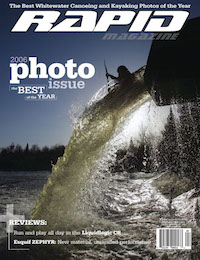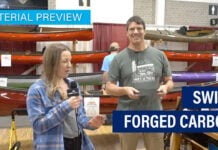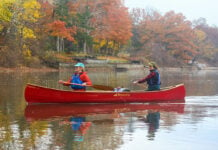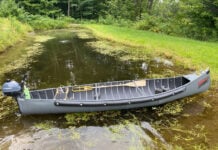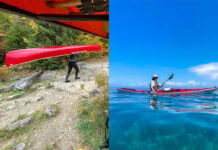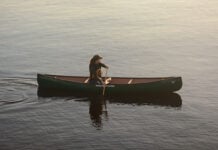Looking back on Esquif’s line of solo open boats it’s easy to spot a trend. The Nitro, Detonator, Zoom and Taureau were all successively shorter (we’ll ignore the slalom-oriented Spark for now). Now bucking its way into the current is the full-bodied, 11’ 3” Zephyr.
Why the retreat from increasingly compact canoes? The Zephyr is Esquif’s admission that many open boaters feel more comfortable in a boat like a voluminous Dagger Rival. So Esquif has taken the speed, stability and dryness offered by a larger hull and added advances in areas such as chine and flare developed for the smaller boats to produce their Zephyr.
Though it’s a full-bodied canoe it doesn’t feel like you are riding a squishy 10-year-old pig down the river. Esquif owner and designer Jacques Chassé says he wanted to impart the responsiveness of his Zoom into a hull with the stability demanded by intermediate paddlers. The chines, though softer than those on the Zoom, still allow for effective carves and off-side tilts. It’s not a pig to paddle because the narrow bow of the asymmetrical hull and the dramatic tumblehome of the gunwales mean you don’t have to reach out over the boat to get your paddle in the water.
The sharper bow entry point, lighter weight, longer waterline and slightly rounded hull (as opposed to the truly flat hull of the Nitro or Detonator) combine to create a boat that accelerates with only a stroke or two and carries speed deep into eddies.
To achieve a cushy secondary stability that stops the boat dead when the gunwales are about six inches above the waterline, Chassé employed a dramat- ic mix of flare and tumblehome. The mid-ship flare gives you something to rest on while the boat is carv- ing and the tumblehome brings the gunwales safely back from the water to produce a really dry ride.
Look closely at the Zephyr’s matte black hull and you’ll notice a woven material visible in the plastic— the biggest story behind the Zephyr is its new hull material. For years whitewater canoes have been produced in composite (fibreglass or Kevlar) or more commonly plastic (Royalex or polypropylene). Esquif has married the two by devising a process that impregnates fibreglass fabric with melted polypropylene plastic instead of resin.
Chassé says the new material—which he calls Twin-Tex—is lighter than straight plastic but not as brittle or susceptible to abrasion as traditional composites.
“It won’t crack like a resin composite, and it won’t gouge, dent or delaminate like Royalex,” says Chassé.
The big question many canoeists are asking is, how will the Zephyr fare when wrapped around a rock? Chassé insists the plastic bounces back, with just a few cracks that can be smoothed over with a heat gun. But the question may be moot given all the floatation in solo boats. Jeff Johnson, head instructor at Ontario’s Madawaka Kanu Centre, says that they haven’t wrapped a solo open boat in years.
Chassé says another selling point of Twin-Tex is its ability to save weight. The Zephyr comes in at 37 pounds. Chassé claims it would have weighed 48 pounds in Royalex.
Long though it may be, the Zephyr is no evolutionary U-turn. Chassé says with the higher production costs of the Twin-Tex material he had to create a boat that would appeal to a wide spectrum of paddlers. Natural selection on the river will likely provide a return on his investment.
Specs
Price ……….. $1,600 Cdn, not outfitted
……………….. $1,300 US, not outfitted
Material……. Twin-Tex
Length …….. 11’3”
Width ………. 29”
Depth………. 16”
Gunwale ….. wood or vinyl
Weight …….. 37 pounds
